Main events of the week[1]
|
The international campaign against ISIS
Attacks by the US and the coalition in Syria and Iraq
- This week US and coalition aircraft continued to carry out dozens of airstrikes in Syria and Iraq using fighter planes, bombers and unmanned aircraft. Following are the locations and characteristics of the airstrikes (CENTCOM website):
- In Syria, the airstrikes were concentrated near Kobani (Ayn al-Arab), where more than ten airstrikes were carried out. The airstrikes destroyed buildings used by ISIS operatives, a tank and battle positions. In the province of Deir al-Zor, an airstrike resulted in the destruction of a tanker belonging to ISIS. Airstrikes were also carried out in Al-Raqqah and Al-Hasakah, where ISIS positions, buildings and oil production facilities were attacked.
- In Iraq, several airstrikes were carried out near Al-Qaim, destroying heavy machinery and battle positions.Airstrikes were also carried out near Fallujah, destroying buildings and vehicles and hitting ISIS operatives. Near Ramadi, an ISIS unit was attacked, and vehicles and checkpoints were damaged. Near Baiji, an ISIS unit was attacked. Buildings and battle positions were destroyed.
Efforts to secure the release of the Jordanian pilot
- There have been unconfirmed reports of attempts by the coalition forces to rescue the pilot. Pentagon officials denied any American involvement in the rescue attempts (NBC, January 3, 2015). A Jordanian source denied reports that ISIS had foiled an air operation to land Jordanian and American forces in order to rescue the Jordanian pilot and other hostages. According to the source, the reports, which were disseminated by ISIS, are false and were issued with the intention of raising the morale of ISIS operatives, who have suffered heavy losses (Asia News Agency, January 3, 2015).
- “Jordanian sources” reported that “extensive diplomatic efforts are taking place [behind the scenes] to secure the pilot’s release.” Mass demonstrations were held throughout Jordan, calling for increased efforts to release the pilot. It was reported that Salafist-jihadi operatives in Jordan have unofficially begun to prepare lists of detainees in Jordanian prisons in advance of possible negotiations on an exchange for the pilot (Al-Quds al-Arabi, January 4, 2015).
Formulating ideas for dealing with ISIS
- New York Times reporter Eric Schmitt reported that the commander of the Special Forces at the US Central Command (CENTCOM) in charge of training Syrian forces to fight against ISIS has put together an unofficial civilian team to formulate ideas for dealing with ISIS. The team includes experts from academia, research institutes, industry experts and people from the business world. They are supposed to analyze the conceptual, marketing and other aspects of ISIS.
- The article said that the team was set up in recognition of the fact that the US is unable to understand the mindset of ISIS, and therefore does not manage to defeat it. The US administration, including the president, is in a state of frustration. This is because, unlike the success of the airstrikes, no progress whatsoever has been made in the battle for hearts and minds against ISIS and so far the organization’s attractiveness in the eyes of foreign fighters has not been impaired. A disagreement arose among the team members over the question of whether the main goals of ISIS are ideological (i.e., disseminating the Salafist-jihadi ideology) or territorial (i.e., establishing the organization’s control and governance in the areas that it has occupied). The team raised doubts whether ISIS “has the bureaucratic sophistication necessary to govern.” (New York Times, December 28, 2014).
Round of training for Iraqi recruits
- On December 31, 2014, the US began the first round of training for the new Iraqi recruits by the international coalition teams.The training is taking place in Camp Taji, north of Baghdad. As a result, the US presence in Iraq is expected to grow from 1,800 troops to more than 3,000. According to Paul E. Funk, the US commander of the force, the number of Iraqi recruits is 1,600 and they are divided into four battalions. The goal is to train 5,000 troops in preparation for an offensive against ISIS to be carried out in the spring/summer of 2015. US military officials stressed that the Iraqi security forces still suffer from significant gaps, including at the logistical level (New York Times, December 31, 2014).
Main developments in Syria

Map of Syria (GOOGLE EARTH)
Kobani (Ayn al-Arab)
- The Kurds claim to have regained control over about 70% of the territory of Kobani, but fierce battles are still ongoing in the city. They say that the blockade imposed on the city a few months ago has been removed and that ISIS operatives have begun to withdraw (www.euronews.com, January 2, 2015). According to one report, the Kurds killed Osman al-Nazeh, one of the senior commanders of the ISIS force in Kobani. Osman al-Nazeh is of Saudi descent. He had a doctorate in law and worked at King Khalid University before joining the ranks of ISIS (Al-Manar, January 3, 2015).
- ISIS continues its modus operandi of using suicide bombers and car bombs in the city of Kobani. Following are photos released by ISIS documenting the detonation of truck bombs in Kobani (Al-Platform Media, January 5, 2015).
The province of Daraa
- Syrian operatives reported that a number of rebel groups, including the Al-Nusra Front, drove out a group that had pledged allegiance to ISIS in the province of Daraa (Al-Darar al-Shamia, December 21, 2014). ISIS recently attempted to infiltrate into southern Syria, where it does not have a significant presence. However, these attempts have encountered resistance on the part of the Al-Nusra Front and other rebel groups, which have so far prevented its infiltration into the area.
Deir al-Zor
- Fighting between the forces of the Syrian regime and ISIS operatives in the area of the Deir al-Zor airfield continues. This week, the Syrian Army intensified its counter attacks in the area of Deir al-Zor. According to reports, many ISIS operatives were killed on January 3, 2015, when Syrian forces repelled an attack by ISIS operatives against several towns west of the city of Deir al-Zor (Chinese News Agency, January 5, 2015).
- On the other hand, it was reported by a jihadist forum that ISIS operatives managed to seize a large quantity of Syrian Army weapons during the attack on the airfield in Deir al-Zor. The weapons seized also include a Metis-M guided antitank missile.
|
The Metis-M is a Russian-made, second generation guided antitank missile. The missile, which has been in service since 1992, has a choice of two warheads: a hollow tandem-type warhead designed to penetrate the reactive armor of modern tanks or a thermobaric warhead designed to hit infantry targets. The missile is used by the Syrian Army. During the Lebanon War, Hezbollah used this type of missile against the IDF. |
Homs
- On January 1, 2015, ISIS issued a video documenting a suicide bombing attack carried out by ISIS at the gas company facility in the town of Furqlus, east of Homs. The video showed two suicide bombers: Abu Ayyub al-Maghribi and Abu Ali al-Maghribi (according to their codenames, they are apparently Moroccan nationals). The two men drove a truck to the gas company's facility in Furqlusand blew it up at the main entrance (YouTube, January 1, 2015). According to reports, five civilians and four Syrian Army soldiers were killed (Daily Star, December 30, 2014).

Top left: Abu Ayyub al-Maghribi. Top right: Abu Ali al-Maghribi. Bottom: The truck bomb used in the attack at the gas facility (Isdarat al-Dawla al-Islamiyya, January 1, 2015).
Damascus
- According to media reports, ISIS has established its control in the Al-Hajr al-Aswad neighborhood (south of Damascus) and has advanced eastward. A few weeks ago, the organization announced the establishment of a branch of the Islamic Caliphate in this neighborhood.
Main developments in Iraq
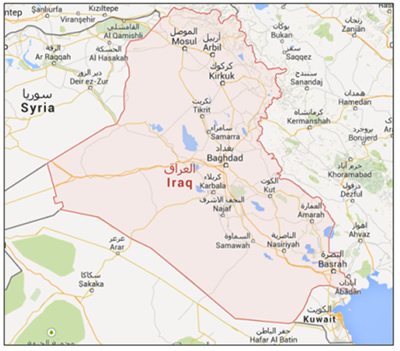
Map of Iraq (GOOGLE EARTH)
The province of Al-Anbar
- In the city of Habbaniyah, west of Baghdad, fighting is ongoing between ISIS and the Iraqi Army. An Iraqi Army source said that during the fighting, an Iraqi aircraft attacked several ISIS positions and three of its vehicles. According to the Kurdish website Shaafaq, ISIS operatives attacked the city of Habbaniyah from two sides on December 31, 2014, and set off a car bomb at a gas station in the city. According to the Iraqi News Agency, the battles in the area continue.
- A few days ago, ISIS published photos allegedly documenting its attack against a large Iraqi Army base near the city of Habbaniyah. The photos show ISIS operatives launching RPGs and firing small arms at the base. Other photos show ISIS operatives manning checkpoints near the base.
- On January 5, 2014, ISIS published photos of the takeover of an Iraqi Army base on the Iraq-Syria border (Justpaste.it):
- On December 31, 2014, ISIS published photos from an attack allegedly carried out by the organization in the area of Ma'amel, northeast of the city of Fallujah, against Iraqi Army forces (Twitter account affiliated with ISIS, December 31, 2014).
The province of Nineveh (northwestern Iraq)
- ISIS carried out a raid on an outpost of the Kurdish Peshmerga forces in Tell al-Reem – Gwer, in the province of Nineveh. The attack began with the launching of Grad rockets from a 4-round launcher, along with mortar fire. Then an APC full with explosives was driven to the entrance to the post and detonated by a suicide bomber codenamed Abu Dujana al-Iraqi (the Iraqi Abu Dujana). The explosion was apparently designed to create a gap in the ramparts in order to enable ISIS operatives to enter the post (Twitter account affiliated with ISIS, December 31, 2014).
The province of Salah al-Din
- ISIS’s security forces foiling effortscontinue. In the province of Salah al-Din, a jihadist forum affiliated with ISIS published information about the exposure of a spy network belonging to the Iraqi regime. The network consisted of eight police officers, who allegedly accepted the authority of the Islamic State. The network was exposed by one of ISIS’s security services called The Special Security Force of the Islamic State. According the ISIS, the members of the network provided the Iraqi security forces with information which was used for attacking ISIS targets (including information about the places of residence of ISIS operatives).
- Following are photos of the execution of the eight members of the network (the Al-Platform Media website, which is affiliated with ISIS, January 5, 2014).
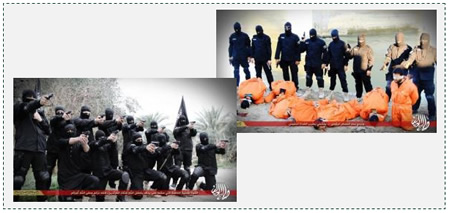
The execution of the squad members (Al-Platform Media, January 5, 2015)
The area of Baghdad
nOn January 3, 2015, ISIS published photos allegedly documenting the organization’s takeover of the Iraqi Army headquarters in Zawba’, near Abu Ghraib (west of Baghdad). The attack took place on January 1, 2015 (Al-Minbar al-Alami al-Jihadi, January 3, 2015).
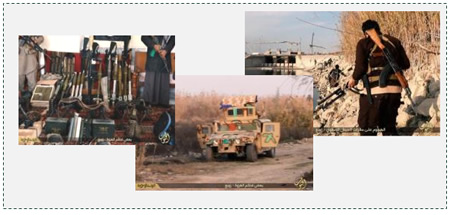
Documentation of the takeover of the Iraqi Army headquarters near Abu Ghraib.Left: Seized Iraqi Army military equipment and weapons. Center: Iraqi Army armored vehicle that fell into the hands of ISIS. Right: Armed ISIS operative (Isdarat al-Dawla al-Islamiyya, January 3, 2015)
Developments in Lebanon
Attack on Hezbollah outpost near the Syrian-Lebanese border (the area of Al-Qalamoun)
- Operatives from the Al-Nusra Front, Al-Qaeda’s branch in Syria, in collaboration with other rebel organizations, carried out an attack against a Hezbollah outpost near the town of Falita, located near the Syrian-Lebanese border (the area of Qalamoun). Following the incident, it was reported that the attackers took over the outpost and killed four Hezbollah operatives. Syrian and Lebanese sources claimed that at least 15 Al-Nusra Front operatives were killed. Several hours later, a counterattack by the Syrian Army forced the Al-Nusra Front operatives to withdraw (Daily Star, January 3, 2015).
The conduct of the Islamic State
Opening an Islamic bank in the city of Mosul (Iraq)
- ISIS opened a bank in the city of Mosul called the Islamic Bank.In the initial hours after the branch opened, customer traffic was sparse, but then it increased. Mohammed al-Hamdani, an Iraqi economist and former executive at Rafidain Bank, estimated that ISIS would soon open branches of the bank in other cities in northern Iraq. Iraqi economists expressed concern that the new bank would be used by ISIS for money laundering and, what is worse, for reducing Iraqi market liquidity (which is already experiencing a severe slowdown due to security problems and falling oil prices).
- Hussein Otabi, professor of economics at the University of Baghdad, estimated that the opening of the bank in Mosul is ISIS’s way of declaring that it is interested in building a strong economy. He warned that if a strong economy of ISIS grows in Iraq, this will lead to increased pressure on the Iraqi government and ISIS’s political demands will only increase (Al-Arabi al-Jadeed, January 1, 2015; Iraqi website Kitabat, December 30, 2014).
Opening a medical school in the province of Al-Raqqah (Syria)
- Arab media reported that ISIS announced the opening of a medical school in the province of Al-Raqqah. Studies will take three years and will include six stages of theoretical studies and practical work. To be admitted to the medical school, applicants must be between the ages of 18 and 30, high school graduates with an average grade of at least 80 (Al-Shuruq al-Yawmi, January 3, 2015).
|
A public maternity hospital operated in the city of Tabqa (Syria)
- A video released by ISIS covers the activity of the public maternity hospital in the city of Tabqa (Syria). In the video, the supervisor of the maternity hospital noted that poor women can get free treatment upon presentation of a required document issued by the Islamic State. The maternity hospital also has ambulances used to transport seriously ill patients to the hospital in the city of Al-Raqqah (Isdarat al-Dawla al-Islamiyya, January 1, 2015).
Jihad-oriented education: guide for mothers
- In the territory of the Islamic State, ISIS published a guide for mothers entitled The Babies of Jihad. The guide teaches mothers how to raise their children to be ready for jihad when they grow up. It states that raising babies for jihad is a mother’s most important task. It calls on mothers to start the training when the children are preschool and not to wait until the age of seven which, according to the guide, could be too late.
- The guide offers a host of activities for mothers to acquaint their children with the ideas of jihad and sacrifice: reading the children bedtime stories about jihad wars; showing them pictures from the internet, including graphic images of the results of terrorist attacks; encouraging them to play with weapons, making sure the children know precisely who they are fighting against. The guide also advises mothers to prevent their children from watching television so as not to expose them to Western culture (Cumhuriyet, January 1, 2015).
|
From ISIS’s perspective, it is of great importance to raise the younger generation in the spirit of Salafist-jihadism. This is part of ISIS’s strategy that aims to foster a new generation of adolescents in Syria who support ISIS’s radical Islamic ideology and are expected to join its ranks when they grow up. |
Brutal application of Sharia law in Iraq and Syria
- ISIS continues the brutal application of Sharia law in the areas under its control. Following are a number of examples:
- The Islamic court in the city of Al-Qaim, Iraq (the province of Al-Furat) cut the hand of one of the organization's operatives, who was convicted of theft. The cutting off of his hand was documented in a video distributed by the organization (Isdarat al-Dawla al-Islamiyya, January 2, 2015).
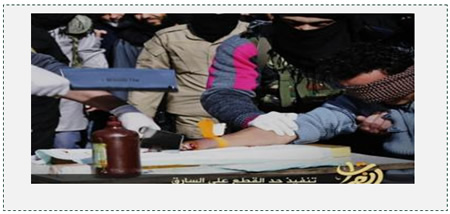
Documentation of the hand being cut off in Al-Qaim (Isdarat al-Dawla al-Islamiyya, January 2, 2015).
- In the province of Deir al-Zor in Syria (Wilayat al-Khayr),three civilians were punished for perjury. Their punishment was being bound to a pole in the main square. Another citizen, accused of possessing obscene materials, was beaten in the main square (Isdarat al-Dawla al-Islamiyya, December 31, 2014).
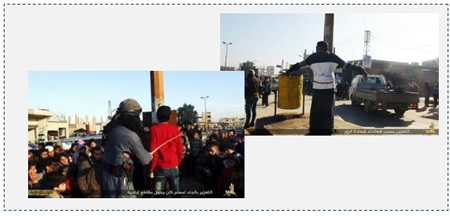
Left: The beating of a Muslim caught in possession of obscene materials. Right: Person accused of perjury being punished by being bound to a pole (Isdarat al-Dawla al-Islamiyya, December 31, 2014)
|
The establishment of Islamic courts and the imposition of Sharia law in all locations controlled by ISIS are of great importance to the organization. The legal system imposed by ISIS on the population includes severe penalties imposed on those who violate Islamic law as perceived by ISIS. This conduct on the part of ISIS is likely to alienate it from the local population, which basically does not espouse the Salafist-jihadi worldview. |
Palestinians and Israeli Arabs
Detention of an ISIS-affiliated squad in Hebron
- In November 2014, near the city of Hebron, Israeli security services detained aterrorist squad ideologically and religiously affiliated with ISIS. The squad operatives are all residents of Hebron. During his interrogation, one of the squad operatives admitted that his intention was to set up an ISIS infrastructure that would carry out attacks.
- To that end, the squad operatives were planning to murder an IDF soldier and use his uniform and weapons to carry out a shooting attack.Two of the squad operatives went to carry out the attack but turned back without having done so. Another of the squad operatives admitted that he had planned to murder an Israeli near the city of Hebron and take away his weapon. The operative also admitted that he and another of the squad operatives made a number of IEDs, one of which was thrown by him at an IDF force (Israel Security Agency website, January 4, 2015).
|
Up to now, only a handful of operatives from Judea and Samaria are known to have joined ISIS or other jihadi organizations in Syria and Iraq. The reason is that the phenomenon of Salafist Islam in Judea and Samaria is not significant and the activity of the Salafist organizations is not established and organized. In the ITIC’s assessment, the operatives from Judea and Samaria derive their motivation and information about these organizations mainly from their websites and are inspired bythem to act. |
Egypt and the Sinai Peninsula
Counterterrorist activity by the Egyptian security forces
- Egyptian military sources in the Sinai Peninsula reported that during an extensive military operation conducted by army forces against the strongholds of armed Ansar Bayt al-Maqdis operatives (the Sinai province of the Islamic State), four operatives were killed and security forces demolished buildings and cars that belonged to the organization's operatives (Ma'an News Agency, December 30, 2014).
- An Egyptian security source in the North Sinai governorate said that the military forces in the Sinai Peninsula had arrested two Ansar Bayt al-Maqdis operatives wearing women’s clothing (while planting IEDs on a road south of Rafah). The IEDs were apparently intended to damage military vehicles (Dot Misr, December 30, 2014).
Attacks by global jihad organizations in other countries
Suicide bombing attack against the Houthis in Yemen
- At least 26 people were killed and 46 wounded, including women and children, in the city of Ibb in southwestern Yemen (200 km south of the capital, Sana'a). The attack was carried out during an event organized by the Houthis (Shiites). On December 31, 2014, a suicide bomber blew himself up at a cultural center where students were celebrating the birthday of the Prophet Muhammad. No organization claimed responsibility for the attack, but similar attacks were carried out in the past by Al-Qaeda in the Arabian Peninsula (Reuters, December 31, 2014).
The battle for hearts and minds conducted by ISIS
Reports on the conduct of the organization in the new issue of the ISIS organ Dabiq
- The sixth issue of Dabiq, ISIS’s online organ, came out in January 2015. The issue begins with an article praising the Australian Haroun Munis, who carried out the terrorist attack in a café in Sydney. According to the article, he attacked the infidels where he should have attacked them: on their own land and in the streets where they walk safely. According to the article, it did not take much effort to carry out the attack, and there will be others in the West who will emulate Haroun Munis.
- Additional articles published in the issue:
- Article about the Abu Hamza al-Muhajer training camp in the area of Fallujah.[2] This camp is intended to provide a basic level of training for its operatives before sending them into battle. The training includes physical training, tactical use of weapons and religious indoctrination.
- Article entitled Action in the New Wilayat [province], which deals with ISIS’s activity in the Sinai Peninsula and Libya.The article claims that, following the announcement of the expansion of the Islamic Caliphate to the Sinai Peninsula, there was an increase in the number of attacks carried out by the organization’s operatives, mainly against Egyptian military and security forces. In Libya, operatives of the jihadist organization that joined ISIS carried out attacks against military targets in Benghazi.
- An article entitled In the Words of the Enemy quotes statements describing the magnitude of the threat posed by ISIS to Israel and the US. The article quoted “the head of the Jewish state” Netanyahu and US Secretary of Defense Chuck Hagel.
|
Dabiq is an online organ published by ISIS and used mainly for propaganda purposes and the recruitment of operatives. The organ is named after the city of Dabiq in northern Syria where, according to Muslim tradition, the decisive battle between Muslims and Christians will be fought. The organ reinforces the religious legitimacy of ISIS and Islamic Caliphate, glorifies ISIS’s achievements, threatens the countries of the West and calls on local Muslim communities to carry out attacks there. |
Propaganda films aimed at conveying the message the life has returned to normal in the areas controlled by ISIS
- ISIS propaganda is striving to prove that in the cities under the control of the Islamic Caliphate, daily life has returned to normal. For example, on January 4, 2015, the Islamic State's Al-Hayat Media Center published a report from Mosul by journalist John Cantlie (a journalist who was taken prisoner by the Islamic State and is being exploited for propaganda purposes). Cantlie is seen walking in the city and describes it as a thriving city under the Islamic State, despite the fact that the global media describes it as a downtrodden city controlled through laws characteristic of tyranny (Al-Hayat Media Center, January 4, 2015). Another video, distributed in the province of Diyala on January 3, 2015, documents the distribution of cooking gas to the province’s residents (Isdarat al-Dawla al-Islamiyya, January 3, 2015). On the other hand, ISIS prevents the publication of information about the difficulties in managing the various provinces and about expressions of resistance among the population, and it imposes strict supervision over journalists working in the areas under its control.
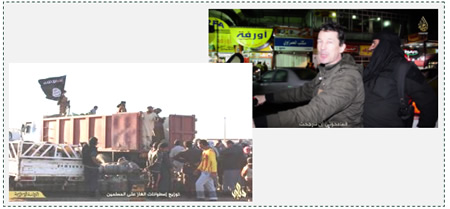
Left: Distribution of cooking gas to residents of the province of Diyala. Right: Cantlie reporting from the city of Mosul (Isdarat al-Dawla al-Islamiyya, January 4, 2015)
Expressions of support and sympathy in the West
Call on Muslims in France to carry out attacks
- Jihadist forums affiliated with ISIS continue to publish propaganda films calling on Muslims in Europe to join the ranks of ISIS and other jihadist organizations. Other films call on Muslimsto carry out terrorist attacks in their native countries in the name of jihad. Here are some examples:
- An ISIS-affiliated jihadist forum published a video in French addressing the “brothers and sisters” in France and calling on them to come and defend their oppressed brethren in Syria. According to the video, if the “infidels” prevent them from emigrating, then they must fight them at home. It addresses the brothers (i.e., fellow Muslims) in France, telling them that they must set France on fire and smash the heads of the infidels. According to the speaker, no special measures are necessary,and knives and stones are sufficient.
Call on Muslims in the Netherlands to join the ranks of ISIS
- ISIS issued a video commemorating the suicide bomber Abu Abdullah al-Hollandi (the Dutch Abu Abdullah) who carried out a suicide bombing attack in Baghdad on November 12, 2014, by means of an explosive belt (killing two officers and wounding 20 Iraqi policemen and 10 civilians). The video shows a young Dutch-speaking operative addressing Muslims in the Netherlands and calling on them to emigrate to the Islamic State and quickly carry out suicide bombing attacks (Isdarat al-Dawla al-Islamiyya, December 31, 2014).

Abu Abdullah al-Hollandi in the video in which he called on Muslims in the Netherlands to join ISIS and carry out suicide bombing attacks(Isdarat al-Dawla al-Islamiyya, December 31, 2014)
Suicide bombing attacks by global jihad organizations
Summary of suicide bombing attacks in 2014
- According to a study on suicide attacks around the world in 2014, published by the Institute for National Security Studies (INSS), the number of attacks in 2014 was 94% higher than in 2013. The study also stated that in 2014 as well, Sunni Salafist-jihadi organizations were behind most of the suicide bombing attacks around the world and that the declaration of the Islamic Caliphate led to a wave of violence, including extensive use of suicide bombing attacks.
- Following are a number of characteristics of suicide bombing attacks carried out in 2014 (for details, see: Suicide Attacks in 2014: The Global Picture, by Yoram Schweitzer, Ariel Levin and Einav Yogev. INSS Insight No. 653, January 6, 2015).
- Most of the suicide bombing attacks were directed against governmental or military targets or local security forces, or were perpetrated in the context of religious and sectarian rivalry.
- The suicide bombing attacks were carried out by around 382 suicide bombers, many of them foreign fighters who joined jihadi organizations, especially ISIS.
- Most of the increase in the number of attacks was in Iraq (271 attacks in 2014, compared with 98 in 2013). The security forces were the target of 71% of all the suicide bombing attacks in Iraq. 17% were carried out against civilian targets and 6% against political targets.
[1]The weekly publication Spotlight on Global Jihad monitors developments among ISIS and global jihad organizations in the Middle East and terrorist activities around the world, directed, supported or inspired by the global jihad organizations in the Middle East.
[2]Abu Hamza al-Muhajer, the successor of Abu Mus’ab al-Zarqawi, is regarded as one of the founding fathers of ISIS.
















